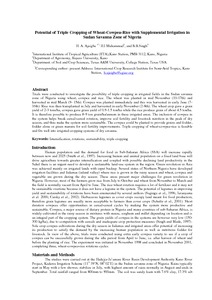Potential of Triple Cropping of Wheat-Cowpea-Rice with Supplemental Irrigation in Sudan Savanna Zone of Nigeria
Abstract
Trials were conducted to investigate the possibility of triple cropping in irrigated fields in the Sudan savanna zone of Nigeria using wheat, cowpea and rice. The wheat was planted in mid November (10-17th) and harvested in mid March (9- 15th). Cowpea was planted immediately and this was harvested in early June (7-16th). Rice was then transplanted in July and harvested in early November (2-8th). The wheat crop gave a grain yield of 2-3 tons/ha, cowpea gave grain yield of 0.9-1.5 ton/ha while the rice produce grain of about 4.5 ton/ha. It is therefore possible to produce 8-9 ton grain/ha/annum in these irrigated areas. The inclusion of cowpea in the system helps break cereal-cereal rotation, improve soil fertility and livestock nutrition in the peak of dry season, and thus make the system more sustainable. The cowpea could be planted to provide grains and fodder, fodder alone or green manure for soil fertility improvements. Triple cropping of wheat-cowpea-rice is feasible and fits well into irrigated cropping systems of dry savanna

